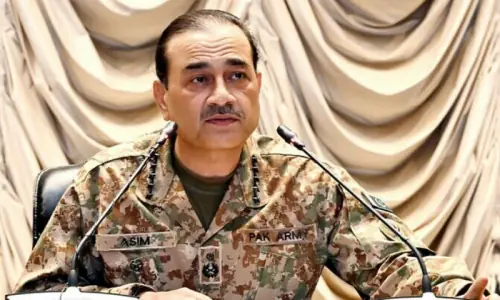
IN 1947, just like the immigrants moving both ways, ‘immigrant newspapers’ had travails of their own to overcome before they could settle down in their dreamlands. Indeed, like, people, many could not survive the transition for one reason or the other. Only a precious few could make it big. Daily Jang and Anjam arrived in Karachi. Civil and Military Gazette could not survive in its own geographical domain. Partaab, Milaap and Veer Bharat left for India.
The 11-year phase at the beginning, till the imposition of martial law in 1958, was probably the most liberal in terms of freedom of expression in the country’s history. Once the boots steeped in, it has been a downhill journey for the press.
In terms of face value, if nothing else, Urdu journalism has dramatically changed over the years. The fonts, the layout, the printing and all other mechanics have been successfully adapted to the modern digital technology. They are for sure better in form and style today than ever.
The art of Urdu calligraphy – Khattatee – is dead, but technology has replaced it with due diligence. Likewise, the gathering, editing, storage and retrieval of data is all done on computers, making the life of sub-editors a little easier. Although technology has to cover a fair bit of journey before it gets completely comfortable with Urdu for all digital platforms and usages, the start is robust. Today, searchable news and classified advertisements are making Urdu readers’ experience with the medium easier by the day. And e-paper websites are giving readers a feel of the paper regardless of their geographical proximity or lack thereof.
This marriage of the traditional and the modern is adding to the experience of Urdu readership. The amalgamation of text, sound and motion on a single platform is merely a look into the future and Urdu journalism has to keep pace with the changing times in order to face off the challenges that stare the global newspaper industry today.
Unfortunately, while efforts have been made to move forward in technological terms, the journey in recent times has been in the other direction when it comes to professional issues, like, say, objectivity and credibility. Press releases still find a market in Urdu newspapers where editors generally prefer them over investigative reporting.
It is not without reason that Urdu journalism is blamed for its campaign-style, hero-driven narratives on history, politics and society. This is critical because, regardless of what it does and how, Urdu journalism remains central in setting the tone of public discourse on issues of significance in Pakistan.
The readers can’t be blamed for it. If anything, it seems to be their preference for objective news and views that political and religious parties struggled to publish their own newspapers in Pakistan with any degree of success. And that has been the case pretty much across the board.
The Ahmadi community, for instance, published Al-Fazal from its headquarters in Gordaspur. It became a daily in 1935 and was shifted to Lahore after partition. The paper could not attract enough readership and was still struggling when it was banned in 1953.
Strange enough, on the other side of the spectrum, the right-wing Jamat-e-Islami could not make its newspapers thrive either. Tasneem and Qasid were published in the 1950s but could not continue for long. The party published Jasarat on March 23, 1970, from Multan and from Karachi a couple of months later.
The paper was banned by the Bhutto government and when it took a new start under the military rule of General Ziaul Haq, the paper had its own problems as the editor developed differences with the government and resigned along with his team. Today, as always, Jasarat has a very low circulation, and apparently the majority of even the Jamaat members don’t subscribe to it.
The Pakistan People’s Party started Musawat from Lahore in 1970. After Zulfikar Ali Bhutto took over power, the paper started its editions from Karachi and Faisalabad. The end of his tenure just about sucked the life out of the paper which was then banned by the Zia regime. It resurfaced in Benzair Bhutto’s second prime ministerial term, but, like Jasarat, suffers from lack of interest even among party activists and sympathisers.
The fate of the newspapers cited above is a clear indication that the readers want balanced reporting. It is up to the newspapers, especially the ones that are part of the national mainstream, to provide them with professional stuff or face extinction.
Away from the news component, columns and opinion pieces remain an important part of a newspaper’s life; Urdu journalism being no exception. Here, again, the vernacular press suffers from some serious ailments that can only be rectified with proper training, education and, indeed, a paradigm shift.
It is not uncommon among Urdu columnists to discuss their personal lives in their writings – sometimes the lives of their kith and kin even! At times, they end up recalling the prophecies they had apparently made in the past. Opinions are mere expressions of the torment or jubilation that the writer has supposedly gone through. There are but a few who stick to professional norms and present an objective point of view with reasoning and data.
Be they news or columns, Urdu newspapers generally are not known for giving due coverage to stories related to human right violations, education, health, women, minorities etc.
The practice of discouraging the award of byline to individual reporters is one of the reasons why reporters generally don’t feel encouraged to move about and dig something out. In the world of Urdu papers, news is what they get from generic sources, such as news agencies, press releases and television channels. Objectivity, balance, fairness and the right to reply are alien alien concepts for Urdu newspapers.
There are communication researchers who believe that the establishment – especially its military component – follows different sets of policies for Urdu and English newspapers in the country. Issues commonly discussed with relative ease in English newspapers bring in their wake immense pressure when discussed in Urdu papers. This pressure comes not just from the establishment; political and religious parties, banned outfits and various pressure groups are all in the fray.
The running thread behind most of these ills, arguably, is the absence of a professional editor who may lead his team along professional lines and protect his colleagues as part of his responsibilities. Even in organisations that do have a professional editor, his hands have been tied by the publishers who have given more powers to the marketing department. In fact, it is the publisher and the marketing personnel who are setting the tone in most of Urdu newspapers today.
The writers are members of the academia.
This story is part of a series of 16 special reports under the banner of '70 years of Pakistan and Dawn’. Read the report here.
































